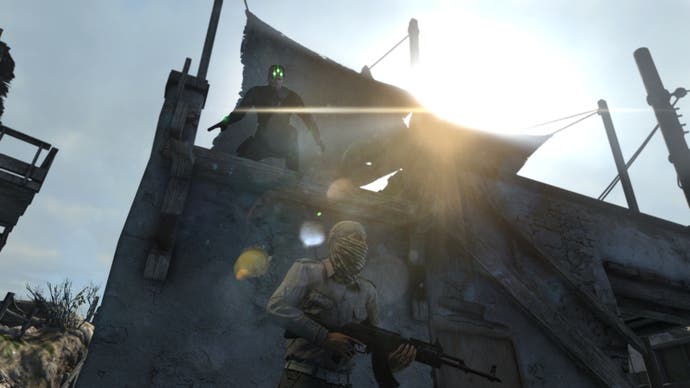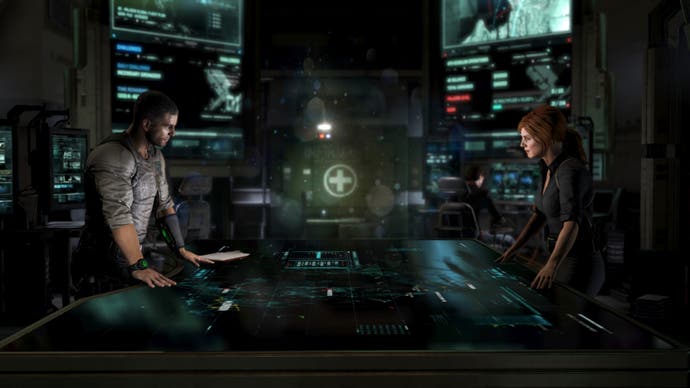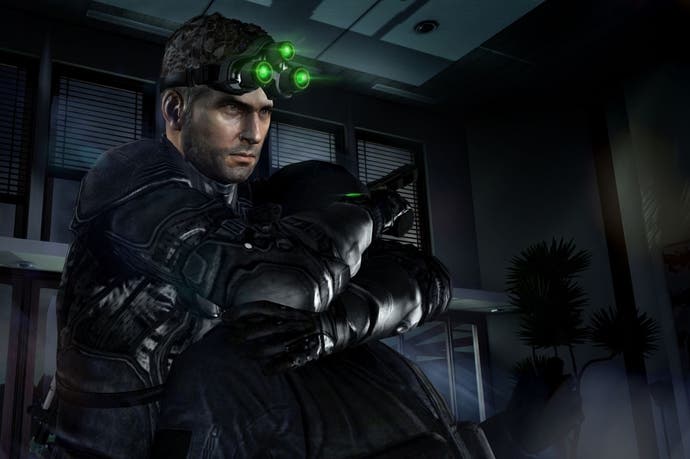Splinter Cell Blacklist review
A drone in the dark.
There's a mission about halfway through Splinter Cell Blacklist where everything clicks into place. You're on foreign soil without permission, you need to break into a military building to steal vital intelligence, and if you don't pull it off then the whole world goes to hell.
A brief cut-scene sets up a scripted sneaking sequence where someone distracts guards while you move quietly through the shadows nearby, dodging security cameras and shinning up drain pipes. But once inside you're quickly double-crossed, left staring down the barrel of a gun. "Grim, now."
It was all part of the plan. The lights go out and machineguns pop off everywhere, but you're already halfway to the ceiling. They need the lights, but you're happier in the dark, killing enemies if you like or leaving them alone if you prefer. Perhaps you get the toys out, using a tri-rotor drone and sticky cameras to scout positions or EMP and noisemakers to create a distraction. Laser tripwires, doubled patrols, RF-coded doors; there's nothing you can't handle.
Once you make it out, leaving the special forces flailing around in the dark, you cap things off with a few drone strikes on the SUVs that pursue you along the highway. Back to base to face the consequences.
When Splinter Cell Blacklist is like this, it's brilliant - a great fusion of cinematic storytelling and expressive gameplay systems in a cool location. But this is a hard balance to maintain. Too often in the campaign, Blacklist feels like it's being pulled in two directions at once, and only one of them is a place you'll want to go.

The scenario might as well be ripped from today's headlines: a global terrorist cell calling itself the Engineers destroys an American base in Guam and threatens to carry out another attack every week until the US withdraws its troops from overseas. In many ways, though, the set-up comes from a less likely source: Mass Effect.
After the initial attack that kicks the game into action, Sam Fisher is drafted in to run a small group of Fourth Echelon operators - some old faces, some new - who fly around the world on an upgradeable plane called Paladin, where you can customise gear, walk around talking to crew members and choose between campaign and side missions from a command console on the main deck. Sound familiar? With his new voice actor and stubble, Sam even resembles Commander Shepard.
If he were, though, he wouldn't be earning any Paragon points. If you've ever wondered where Tom Clancy would stand on Edward Snowden, the answer is "his throat, with spiked shoes", and Blacklist is a faithful extension of his worldview. As terrorists upset with US interventionist policy hatch plots against the homeland, Fisher jets around the globe, snatching people, torturing guards and stealing intel, rarely pausing to consider the irony of his situation.
In fact, Fisher rarely pauses to consider anything. Nor does anyone else. New guy Briggs gets a bit of an arc - foolishly putting someone's life in front of the mission but getting the chance to make amends later - but there is no evidence anyone else grows as a person by the end of the game. Fisher can call his daughter or chat to his team between missions, but there's no way to steer these personal connections, which are optional anyway. They feel like it. In a year where homicidal gameplay has felt at odds with storytelling, Blacklist is at least coherent.

Much like the US Intelligence Community it openly endorses, then, Blacklist is more concerned with events than people, but at least those events make for interesting levels. Splinter Cell always feels most fun when you're using light, shadow, cover and a wide range of tools to manipulate enemies, and once you've unlocked a few gadgets and settled into its rhythm, the settings in Blacklist are rich with potential.
Whether it's a moonlit assault on a well-protected villa or an in-and-out job on a famous US military base, there's a lot of playground to explore and a welcome gimmick or two - like creeping through a house using sonar to find a weakness in the shell of the owner's panic room. There are side objectives, too, like data sticks to retrieve, laptops to hack and high-value targets, who you have to subdue in a quiet spot rather than killing from afar. When it all comes together, it's great fun concocting and executing small plans that push you towards your broader objective, and even recovering the situation is enjoyable with the right tools.
Blacklist is most entertaining at night or indoors, where you can extinguish light sources and feel more like a predator, but there are also quite a few daytime missions. By day, especially out in the open, you're far more reliant on cover, while enemies roam more boldly and see further, and consequently you feel more like the hunted than the hunter. You can tag enemies to keep track of them and use the mark-and-execute instakill button - returning from 2010's Conviction - once you've charged it up, but any bodies will be easily seen by remaining guards. The odds are always against you when the lights are on, and harder to turn in your favour.
This is less fun, then, but it isn't only daylight that's to blame; wrinkles in the cover mechanics don't help. You can't slip round corners easily or take cover on stairs, and when there are several contextual actions too close together you can easily choose the wrong one, leading you to hop over a fence when you meant to scale a pipe. Fisher also moves clumsily for a modern third-person game hero and feels unreliable in and around cover in general. A first-person option with the precision of Deus Ex: Human Revolution would have been welcome.

The game does a good job of rewarding your performance, at least, handing out bonuses in three categories: ghost, panther and assault. The idea is that you see a strong return on your efforts however much you like to get your hands dirty, and while ghost play is rewarded slightly more than anything else, the knowledge that Blacklist also respects someone who knifes a guard from above as much as someone who likes throwing incendiary grenades out of air vents gives it a more egalitarian feel than most stealth games. It also encourages you to be more experimental, which is when the game feels strongest.
It's a shame, then, that the weak story exerts such a strong pull on proceedings, because it's often to the detriment of these strengths. Before you can even access the game menus, you're forced to play through a scripted pre-credits sequence that sets up the story and installs Shepard, I mean Fisher, on the Paladin with his colleagues. It's only then that you can calibrate your in-game brightness, set the screen corners and even access multiplayer - all because the story comes first.
Then in the first mission proper, where you creep around using the harsh shadows of Benghazi to learn the mechanics and how to have fun with them, the game can't wait to break its own rules and tear you out of your flow with a scripted sequence where you have to drag a prisoner through a police station. On the higher difficulty levels, this section is virtually impossible to complete, because you can't crouch or move freely and your only offensive weapons are grenades and an unsilenced pistol.
Not all the game's cinematic intrusions are so jarring, but the story feels like an unwelcome companion throughout, dragging you away from what makes Splinter Cell interesting. That's not so bad in a game like Deus Ex or even Mass Effect, of which the Blacklist hub designers were so fond, because you care about what happens in those stories, but this is just paranoid conspiracy gibberish, shining a light into dark places and finding exactly what it needs to justify the excesses of its protagonists. None of it is convincing, and its conclusions will be laughable to anyone who has picked up a newspaper recently who doesn't work for the NSA.

Fortunately, that's only where the game's story ends. Ours continues into Spies vs Mercs, the classic multiplayer mode that returns following its surprising absence from the last Splinter Cell. It's still an asymmetrical team game where fragile spies use their agility and gadgets to reach and hack terminals while heavily tooled mercs strut about in first-person trying to take them down, and it's still great.
SvM Classic is 2v2. Spies have night-vision goggles and an EMP gun that allows them to get close and one-hit-kill their enemies, while mercs have a torch that can blind spies and heavy weapons for doing away with them. Match settings can be tweaked to reflect the set-up in previous games, although the customisation options found elsewhere in Blacklist are absent. They come into play in SvM Blacklist, which increases the team size to 4v4 and allows for custom loadouts. This really changes the dynamic. Spies have access to different vision modes and small machineguns, for instance, which makes a big difference.
It's hard to say how SvM Blacklist will balance out in the long run until people get used to the different loadouts and maps, but it's immediate fun. More importantly, though, SvM Classic lives up to its name. The lights are turned down on every map so there are huge pools of shadow everywhere, and the tension is riveting as spies activate terminals and try to stay out of the mercs' sights long enough for data to transfer. There's still nothing else like Spies vs Mercs, and in Blacklist it benefits from modern game mechanics and level design, giving it new legs. It's easy to see how it went on to inspire the equally brilliant multiplayer in Assassin's Creed.
Spies vs Mercs saves Blacklist from the ignominy of being merely good. Like Hitman Absolution last year, the campaign feels like a fun game bogged down by its desire to look like a stylish action thriller; it's cavalier with its politics and your time, and on occasions you'll wonder why you bothered to negotiate with these terrorists. But when the game clicks, which it does often enough across its many modes and missions, it overcomes the inadequacy of its storytelling and reminds you why Splinter Cell was so appealing in the first place.








